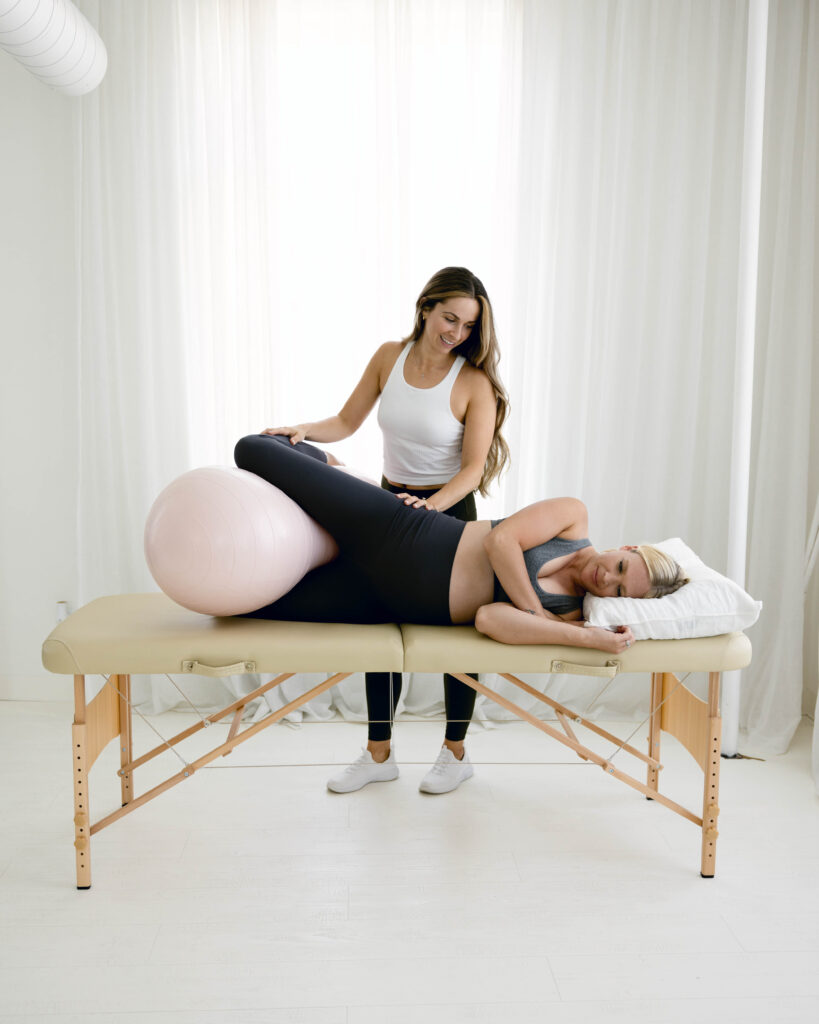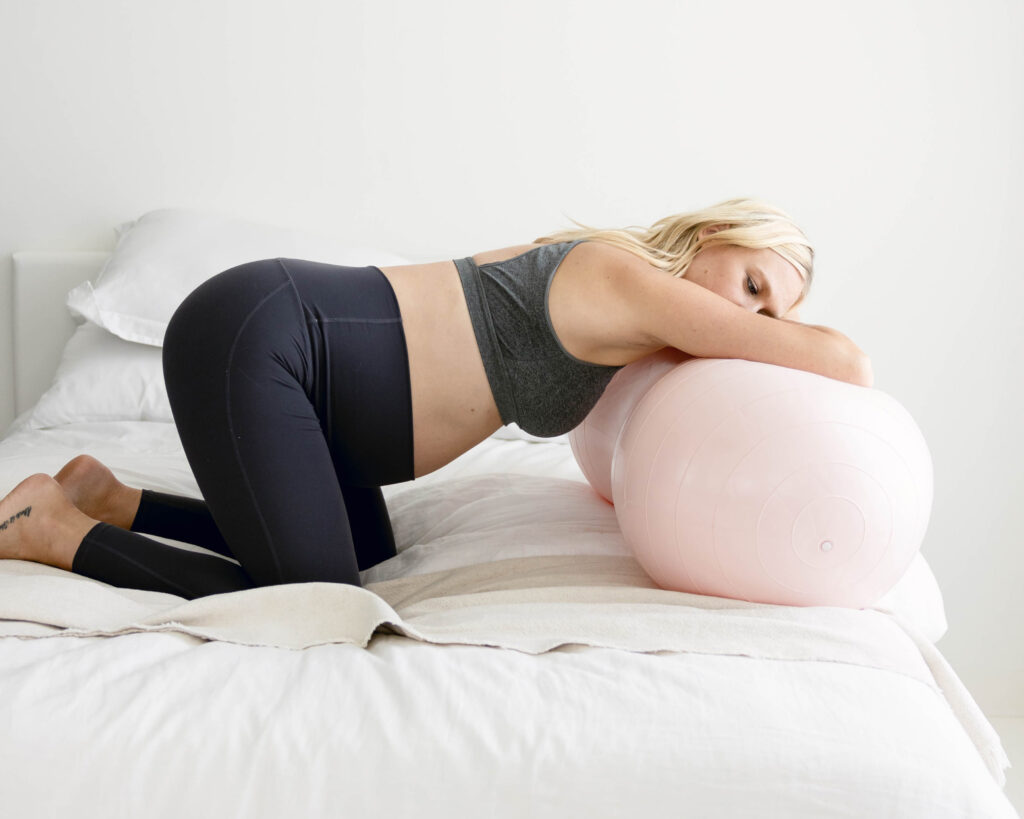4 Ways to Use a Peanut Ball During Labor

Disclosure: I only recommend products I would use myself and all opinions expressed here are our own. This post may contain affiliate links that at no additional cost to you, I may earn a small commission.
Labor and delivery is one of the most challenging and rewarding processes I’ll ever experience. Whether you’ve birthed a child before or you’re preparing for your first time, you probably have some breathing exercises, positions, and comfort items ready for the big day.
Thankfully, there are so many different types of tools we can use as women in labor today! From heating pads and ice packs to manage temperature and pain to playlists that make us feel powerful and showers or tubs to offer hydrotherapy, I’m grateful for everything we have at our disposal these days. One of the most popular tools my clients use is a birth ball — it provides support for so many labor positions, and it’s a versatile option to use in your labor prep exercises as well.
You’ll never hear me disparaging the traditional birth ball, but I might be an even bigger fan of the peanut ball! This little nugget is an invaluable tool during almost every stage of childbirth, and I used it in my own delivery when I had my daughter, Ava! If you’re not familiar with it yet, this post might just convince you to add it to your childbirth tool roster.
What is the peanut ball?
The peanut ball looks like… well, a big peanut. In some ways, it offers similar support to the traditional round birth ball, but the unique shape gives it some unique advantages as well. Peanut balls have really grown in popularity recently, so if you’re planning to deliver in a hospital or birthing suite, there’s a good chance your facility will have one on hand. (I definitely recommend checking first, though — preparation is key to relieving stress when the big day arrives!)
The peanut ball’s shape and dimensions allow for optimal positioning of the pelvis during each stage of labor. It also reduces the tension in your legs, which makes it a great place to rest between contractions, or even throughout labor if you choose to have an epidural.
Benefits of using a peanut ball
Using a peanut ball during labor is about much more than just comfort. This little tool provides some serious benefits!
Eases pelvic pressure
As your body prepares to deliver a child, pelvic floor pressure can escalate quickly. It makes sense that your pelvic floor muscles will feel this tension, but without alleviation, you can experience more pain and tearing. The leg support of the peanut ball can ease any pelvic pressure and discomfort you might have during labor. In fact, I even have patients note how comfortable the peanut ball is during their labor prep appointments with me!
Promotes optimal baby position
As you progress through the stages of labor, your pelvis will shift and open to create more space for your baby to descend into the birth canal. Sometimes, these progressions need a little help — and the peanut ball can provide it! The peanut ball is an especially valuable aid for epidural patients. Once that kicks in, you’re not able to move around as much, which often negatively impacts baby’s position. Using the peanut ball can help you compensate for your lack of movement as you progress!
Facilitates labor progress
Labor is empowering and incredible, but we mamas are usually here for anything that will keep the process moving right along! Prolonged labor is never fun, and the peanut ball can help shorten labor by getting your body into the right positions for progress. By promoting optimal position and alignment, your body will recognize that it’s time to keep going and welcome baby into the world. Again, this is especially helpful for epidural patients!
Talk to your doctor or doula ahead of time to map out your birth plan, but know that the peanut ball is a valuable resource at many stages of labor! Most providers encourage using a peanut ball to allow you to “labor down.” If that’s a new term for you, it simply means your cervix is fully dilated and effaced, but the baby is still not low enough to begin pushing. Positioning yourself correctly on the peanut ball can help your baby drop into the right position to push!
Can reduce medical interventions
Before diving in, I want to be clear: if you do need medical intervention during labor and delivery, you didn’t fail. Sometimes, your body just needs extra help getting your baby into the world safely, and I’m thankful for the modern tools we have available to support us today. That said, using a peanut ball can sometimes reduce your need for those interventions!
As we’ve already discussed, the peanut ball promotes proper alignment and laboring down, which allows baby to descend low into the pelvis prior to pushing. But how does this relate to medical intervention? If your baby can naturally get low enough into your pelvis and aligned properly for pushing, there won’t be as much of a need for a cesarean section, or external assistance with tools like forceps or a vacuum. Proper alignment and positioning can also reduce perineal tearing during labor — if you’re interested in digging into those details, I wrote an entire blog about this topic.
No birth goes exactly as planned, but you can prepare your body for the best possible labor and delivery outcome long before you walk into your birthing suite. My newest course, Movement through Labor and Delivery, is almost here, and it’s designed to help you prepare and plan for your preferred birthing experience in every way, whether you want an epidural in the hospital or a medication-free birth at home.
4 ways to effectively use a peanut ball
Have I sold you on the effectiveness of the peanut ball yet? I sure hope so! Here’s how to use it once labor has begun.
- Side-lying: You can get into this position by putting the peanut ball between your knees to open the top of your pelvis or between your feet to open the bottom of your pelvis right before pushing. You can also get into an asymmetrical position with your top leg on the ball and your bottom leg straight, which helps to open the midpelvis. Side-lying is helpful during pretty much every stage of labor if you want to coax baby into position!

- Semi-reclined: If you need a position you can relax in (and every mama does at some point during labor), lean back and drape one leg over the peanut ball. This comfortable position will still promote labor progress.

- All fours: If you’re experiencing back labor, try getting into all fours with the peanut ball underneath you for added support. This is also a great pushing position, because it allows for free movement of the pelvis as needed.

- Throne: Sit tall and upright on the peanut ball to allow more freedom of movement of the sacrum and coccyx. Upright positions use gravity to help the baby descend lower into the birth canal so you can push effectively. If you’re experiencing back labor, this may not be the best position for you, but it’s pretty helpful in most other scenarios.

Grab your peanut ball and get ready to welcome your baby into the world, mama! And if you’re looking for additional labor and delivery support, check out Movement through Labor and Delivery. This online childbirth education program was developed by a pelvic floor PT (that’s me!) and a certified nurse midwife. Together, we’ll help you prepare your pelvic floor for birth so that you can walk into labor feeling confident and equipped with the knowledge and tools you need. Movement through Labor and Delivery is available now, and we would love to help you prep for childbirth in a comprehensive and empowering way!
Hi